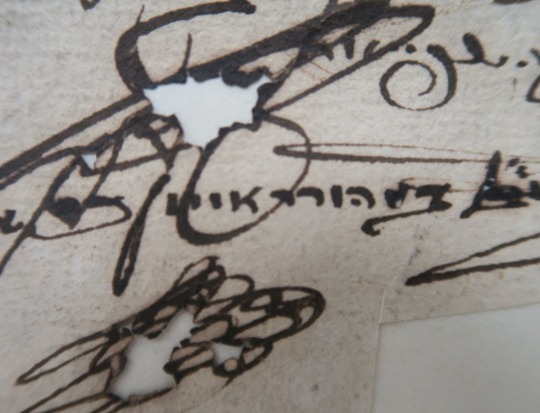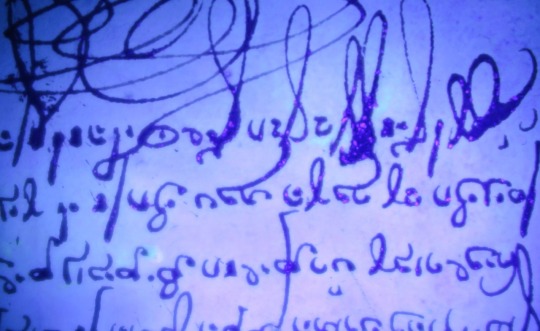By Dong Eun Kim, Head Conservator, Center for Jewish History
Post 2
In the previous blog post, the Werner J. and Gisella Levi
Cahnman Conservation Laboratory had received the Leo Baeck
Institute’s Metz Jewish Community Collection for assessment and treatment. The
Conservators in the lab were captivated by these artifacts; we felt there was
something truly important about them, yet none of us could identify what it was
that made them feel so special.
Before finding the answers, we were
about to embark on a journey of fascinating dead ends. Our investigation
begins with a condition report, an assessment of the state of the artifact. We
identified Iron Gall Ink in the intermediate stage of oxidation. In some cases
large deposits had faded through to the verso (back), and in others it had deteriorated and degraded the paper, causing cracks and
losses due to corrosion.


Detail photograph
showing loss of paper (top) and crack (bottom) due to ink corrosion, Leo Baeck
Institute ArchivesPhoto credit: Dong Eun Kim
Treating this requires meticulous
examination, using light tables and even microscopes to identify problem areas.
This inspection exposed a compelling new detail: in several places, the ink
seemed to have a gold sparkle to it, almost like glitter. Magnification and UV (ultraviolet) fluorescent light revealed colored particles, like grains of sand. The material
appeared throughout several of the manuscripts.
We were delighted and intrigued by this new detail, and
began appropriate analysis to understand what we were seeing.

Detail photograph showing sparkling
letters photographed under visible light, Leo Baeck Institute ArchivesPhoto credit: Dong Eun
Kim

Detail photograph
showing glittered letter photographed under UV light, Leo Baeck Institute
ArchivesPhoto credit:
Dong Eun Kim

Detail photograph
showing “blotting sand” under high magnification, Leo Baeck Institute ArchivesPhoto credit: Dong Eun Kim
Research revealed the gold particles as “blotting
sand,” a substance “applied to wet ink for centuries with the intention of
speeding up the drying time of writing inks. Blotting sand consists of small
particles of a variety of materials (minerals, bio-minerals, glass, metal and
others).” (Reference: Reissland et al. 2006, Milke et al. 2003)
A remarkable find, but entirely common in documents from the
time period. Necessary information for effective treatment, yes, but we are no
closer to understanding why these objects feel so intriguing. We press on…if
not the ink, perhaps the paper it’s printed on?
Careful examination
of one of the documents revealed a watermark, which often helps in identifying
historical elements. This gave us a new avenue of research, offering new hope
of discovering the importance of the artifact.
Paper watermarks are
the designs left in the paper from the structure of the paper mold. Wire
threads are sewn onto the mold wire cover, producing thick or thin sections of
the paper during its manufacture, and forming an image that can be seen when
holding the paper up to a light source or in raking light.
Due to
heavy writing on the page, the watermark was very difficult to identify. By
combining two pages with partial watermarks, we were able to get a sense of the
whole. The
design includes an inscription circle topped by a crown, which surrounds a lion
and plinth; it appears to contain a phrase beginning with the words ‘pro
patria’, which is similar to those found in Dutch and English papers in the
18th century. It is about 4
inches wide and shows the lion carrying a corn sheaf and a spear, standing on a
plinth with the letters ‘VRYHYT’.

Detail photograph
showing watermark under transmitted light, Leo Baeck Institute ArchivesPhoto credit:
Dong Eun Kim
Because versions of this
watermark were commonly used by Dutch and English paper makers, they may have
been from one of a dozen different paper mills. The missing “E” on the plinth
likely indicates a lesser known manufacturer, which leaves us without enough
data to reach a conclusion about the paper’s origin.
However, handmade paper was
made on a mold that had chain wires laced or sewn directly onto the wooden ribs
of the mold. This caused the pulp to lie heavier along each side of every chain
line. European paper made before 1800 may often be distinguished by this
peculiarity. One of the methods used in paper analysis is the measurement of
these features, and the measurement distance between chain lines in this case confirmed
that this paper was Dutch and not English.
As rewarding as it felt to
have identified the country of origin for the paper, it offered no new answers.
Dutch-made paper in the 1700’s was quite common all over Europe and even abroad
– even the original draft of the Declaration of Independence was written on
Dutch paper.
Why are we still so compelled
by these objects?! Frustrated but undaunted, we persevere…
